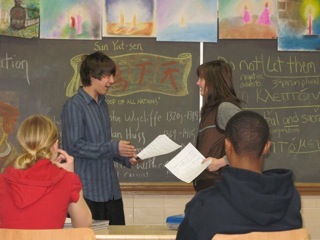Eighth Grade
 Developmental Profile of an Eighth Grade Child*
Developmental Profile of an Eighth Grade Child*
At 14, the pupils are “into” adolescence: bodily and psychological changes are well under way, so that in general, the young person seems more robust and the tenderness of the previous two years has lessened somewhat. Growth in height and sexual development are clearly established, with the onset of voice change in boys and the establishing of the menstrual cycle in girls. At this age, the world of ideas begins to take on meaning for the young adolescent and the critical faculties of the 14 year old are noticeably sharper and parts of the accepted framework—particular rules for example—are subject to questioning scrutiny. Counter balancing this critical tendency is the emergence of reasoning or a “reasonable” side in the child.
Educational Experience
A Waldorf eighth grader experiences a gradual but significant shift from the presentation of a subject solely from the teacher to the class, to the mutual consideration of a subject by teacher and class together. A sense of community develops, in which speaking becomes more thoughtful, listening more attentive. The result is a greater sense of self. The students expand their sense of place in the world. More importantly, they leave with compelling questions that will continue to fuel their love of learning in the years ahead.
|
History/Social Studies
|
1700-present; American history. |
|
Literature
|
Shakespeare, epic and dramatic poetry. |
|
English and Grammar
|
Grammar, composition, business and practical writing, debate. |
|
Foreign Language
|
Emphasis on vocabulary building and dialogues. |
|
Geography
|
Asia, Australia and Antarctica; global contrasts. |
|
Sciences
|
Chemistry, physiology, physics. |
|
Mathematics
|
Practical mathematics, percent, equations, algebra, ratios, geometric calculations. |
|
Music
|
Boys / girls choir; junior high orchestra. |
|
Drawing
|
3-dimensional drawing, volumes. |
|
Painting
|
Discover space in color. |
|
Handwork
|
Use of sewing machine. |
|
Woodwork
|
Construction of clocks with fine detail work and rough-cut three legged stools. |
|
Modeling
|
The human head in clay. |
|
Eurythmy
|
Improvisation, production & performance. |
|
Physical Education
|
Gymnastics with equipment; team games and sports. |
* The Educational Tasks and Content of the Steiner Waldorf Curriculum, Edited by Martyn Rawson and Tobias Ritcher


